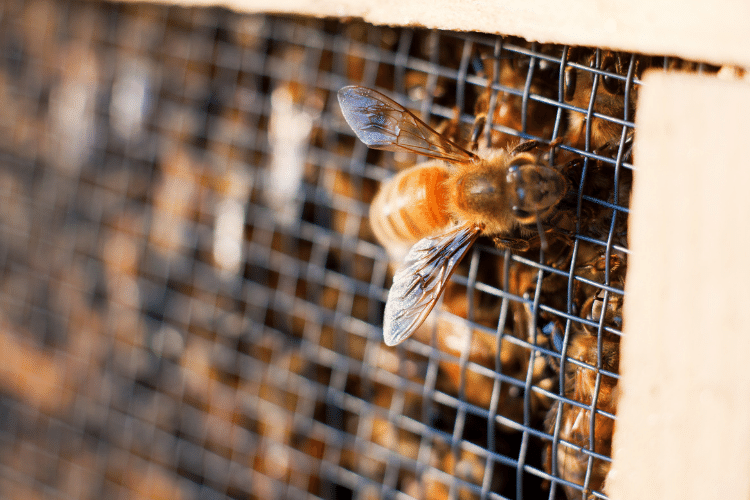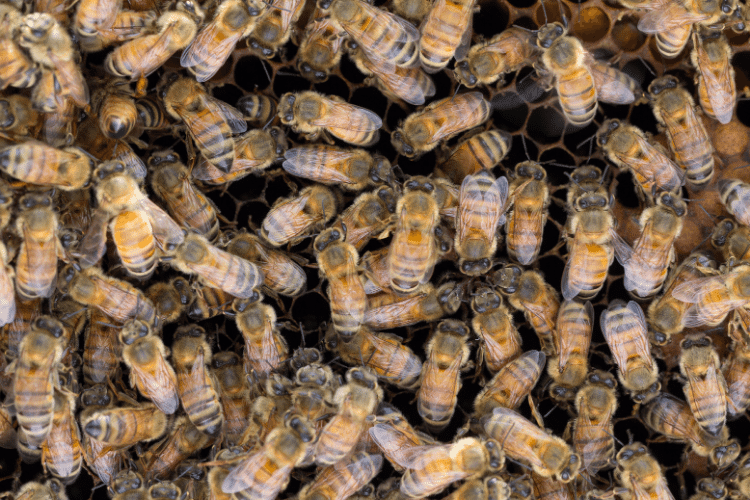Just like all the creatures on earth, honey bees have various breeds. Russian and Italian honey bees are two of the most common bee species.
When it comes to Russian honey bees vs. Italian bees, you can’t say there’s a breed better than the other. Generally, each type of bee can work best in specific locations and conditions.
Whether you’re an amateur or professional beekeeper, knowing the differences between bee species is essential. Check out the following comparison between Russian and Italian honey bees and learn more about them.
Russian Honey Bees vs. Italian Bees: An Overview
Russian and Italian honey bees both make great options for beekeeping. They’re hardworking, excellent honey producers, and have many positive characteristics.
However, learning more about their differences can help you make the decision when choosing between the two species.
What Are Russian Honey Bees?
Russian honey bees (Apis millifera) were first introduced to the U.S. beekeeping community in 1997. The main purpose of bringing them was their excellent pest resistance abilities. With time, Russian honey bees became more popular among local beekeepers.
Pros
- Can overwinter on a tight honey and pollen reserve during colder climates.
- Resistant to many types of pests, especially tracheal and varroa mites.
- Available for sale in the U.S.
- Highly productive species.
Cons
- Slightly aggressive nature.
- High swarming tendencies if not managed properly.
- Mostly tougher to requeen than other species.

What Are Italian Honey Bees?
Italian honey bees (Apis mellifera ligustica) are the most popular among beekeepers all around the world. They’re also the most popular and common bee race in North America.
That’s because they’re easy to manage by beekeepers. They can also adapt to variant climate conditions.
Pros
- Gentle and docile, making it easier to perform beehive inspections.
- Have great honey production levels.
- Excellent at building hives.
- Hardworking and amazing foragers.
Cons
- Their high brood rearing can lead to overpopulation and sometimes starvation, especially with no foraging in cold winters.
- High tendencies of robbing and swarming.
- Susceptibility to pests and diseases.
Russian Honey Bees vs. Italian Bees: A Comparison
By now, you should have a general idea about the two species. Thus, it’s time for an in-depth head-to-head comparison between Russian and Italian honey bees.
Both species have distinctive bodily features and colors. Yet, what matters most to beekeepers is the bees’ character traits.
Here are eight of the most distinguishable differences between Russian and Italian honey bees.
1. Origin
Honey bees aren’t native to North America. Rather, they were brought to the U.S. from Europe around the 1600s. The region where honey bee species originate has a major effect on their characteristics and behavior.
That’s why knowing where certain species come from is essential for learning how to deal with them.
Russian Honey Bees
As the name suggests, Russian honey bees come from Russia, specifically from the Primorsky Krai region. They’re mostly known for their ability to tolerate some harmful pests. That’s why the United States Department of Agriculture (USDA) introduced the species to the U.S. late 1990s.
As of 2000, this species was available to the public market for local beekeepers to buy.
Italian Honey Bees
Italian honey bees originated from southern Italy around the Apennine Peninsula. They were brought to the U.S. in the mid-19th century as a perfect replacement for German bees. Now, Italian honey bees are available worldwide, from Europe to the far east.
2. Shape and Color
When you pay close attention, you can see that different bee species don’t usually look the same. Some may have rounded abdomens, while others have more tapered bodies. Similarly, various species can differ in color as well.
In general, the more experience you have with bees, the more you’re able to differentiate between their species.
Russian Honey Bees
Russian honey bees have that distinctive classic black and gold striped look. However, their color tends to range from dark brown to black, while their golden stripes are more of a pale yellow.
That said, the whole colony may have a change of appearance if the requeened bee mates with other drone brees.

Italian Honey Bees
Italian honey bees have smaller bodies and shorter hairs than Russian honey bees. They’re typically light in color, ranging from brown to pale yellow. Still, they have alternating brown or black stripes on their abdomen.
It’s quite easy to identify their queen as it’s noticeably darker in color than the whole colony.
3. Behavior and Nature
As a natural defense mechanism, bees sting. That’s why many people fear them. Unless disturbed, honey bees shouldn’t be much of a threat to human beings. In all cases, learning about bee behavior can help you predict their reaction when dealing with their hives.
Russian Honey Bees
In general, Russian honey bees have gentle temperaments. Although they’re known to be aggressive, it’s not something an average beekeeper can’t manage.
Italian Honey Bees
Italian honey bees are noticeably more docile and calm than Russian bees, which can make the inspection process stress-free.
4. Honey Production
Bee hives in variant locations produce different amounts of honey. This depends on the bees’ species, water sources, weather conditions, etc.
Russian Honey Bees
Russian honey bees can manage their production with regard to the weather as well as the availability of nectar and pollen. They’re able to scale back or ramp up honey and brood production according to their foraging availability.
Italian Honey Bees
Italian honey bees can’t control brood or honey production. They can work continuously through the warmer seasons as long as the resources are available. As a result, they may run out of hive space quicker than other species.
That’s why beekeepers should keep an eye on the hive, as this may lead to increasing their tendencies to swarm.
5. Mite Resistance
Many pests and mites can affect bee hives, causing a decline in the colony population and the deformation of bees. Identifying and addressing such issues as early as possible helps a lot in fighting these parasites.
Russian Honey Bees
Russian honey bees have excellent resistance to parasitic mites, such as Varroa and tracheal mites. They constantly work to uncap affected cells and kick out any intruders that dare to attack their house.
Italian Honey Bees
Italian honey bees aren’t as strong in fighting parasites. Due to their continuous rear brooding, they provide these harmful mites with excellent hiding places.
6. Tendencies to Swarm

Swarming is a natural process that happens often in the honey bee world. It’s mostly the result of overpopulation in the colony. This leads the queen to leave her original hive with about half the worker bees to find a new nesting location.
Although it’s a sign of a healthy bee hive, it can cause frustration to some beekeepers.
Russian Honey Bees
If not managed well during the period of excess pollen and nectar, Russian honey bees have a high tendency for swarming. That’s why it’s important to take precautions and allow more room for the colony to grow.
Italian Honey Bees
Italian honey bees are much less inclined towards swarming than other species. However, they do swarm in some instances. This usually happens during the spring and summer seasons. Thus, beekeepers should add extra brood boxes to reduce this behavior.
7. Robbing
In many occurrences, honey bees can invade other hives to steal their honey or nectar. That happens especially when nectar resources aren’t as widely available as usual.
Russian Honey Bees
Because of the Russian honey bees’ ability to reduce brooding during nectar shortages, they’re not likely to rob. They just wait and live on what they have until things get better.
Italian Honey Bees
Italian honey bees’ rear-brooding patterns often cause them to run out of food. That leads them to rob other colonies to feed their young. What’s more, because they’re not that aggressive, Italian honey bee hives are the most likely to be robbed as well.
8. Requeening
Beekeepers often use requeening to replace the current hive queen with a queen of another breed. They may also do it to change the old queen to a stronger one with better egg-laying capacity.
Russian Honey Bees
Overall, Russian honey bees can be challenging to requeen and may require a long time to accustom to new situations. Sometimes it might take the Russian queen over two weeks to start laying eggs.
Italian Honey Bees
Italian honey bee hives accept new queens quite quicker than Russian bee hives. Because of that, the Italian queen can start laying eggs much sooner as well.
Russian Honey Bees vs. Italian Bees: Which Species Is the Best?
Both Russian and Italian honey bees are great choices for beekeepers of various experience levels. Among the best qualities of Russian honey bees is their ability to fight off harmful parasites. Moreover, their adaptability to changing conditions is impressive.
On the other hand, Italian honey bees are easier to manage and have great productivity. That’s why many beginner beekeepers prefer this species.
Conclusion
Choosing between Russian honey bees vs. Italian bees shouldn’t be hard. After all, both species guarantee an excellent hive with highly productive workers.
All you need to do is read more about different bee species and learn their special traits. Remember that performing regular inspections is also vital to detect any issues as early as possible. This way, you become able to manage the hive successfully.
- Does Bleach Kill Bees? - April 23, 2024
- How Do I Get Rid of Ants Without Harming Bees? - April 16, 2024
- Do Bug Zappers Kill Bees? Completely Explained - April 9, 2024
